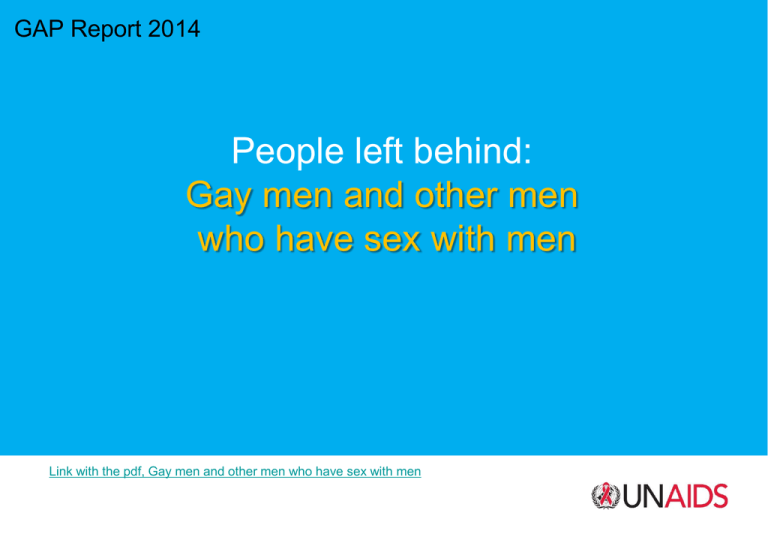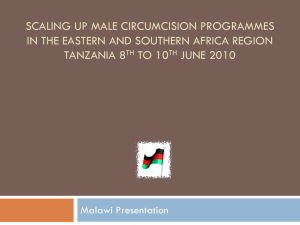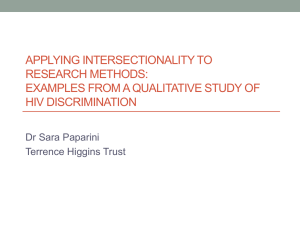
GAP Report 2014
People left behind:
Gay men and other men
who have sex with men
Link with the pdf, Gay men and other men who have sex with men
I am gay.
I face these issues.
HIV burden
• While HIV incidence is declining in most of the world, incidence among
gay men and other men who have sex with men appears to be rising in
several regions, including in Asia, where this mode of transmission is a
major contributor to the HIV epidemics in several countries.
• Worldwide, gay men and other men who have sex with men are 19 times
more likely to be living with HIV than the general population.
• The median HIV prevalence among gay men and other men who have
sex with men is 19% in western and central Africa and 13% in eastern
and southern Africa.
• Gay men and other men who have sex with men often acquire HIV while
quite young—HIV prevalence is about 4.2% for young (under 25 years)
gay men and other men who have sex with men.
• Seventy-three countries did not report data on HIV prevalence among
gay men and other men who have sex with men.
HIV prevalence among gay men and other men
who have sex with men across regions, 2013
Asia and Pacific
Caribbean
Eastern Europe and central Asia
East and southern Africa
Latin America
Middle East and North Africa
Western and central Europe and North America
Countries
by
region
Countries
by
region
HIV prevalence (%)
Source: Global AIDS Response Progress Reporting 2014.
West and central Africa
HIV prevalence (%)
HIV prevalence among men who have sex with men
and the general population by region, 2009–2013
Region (number of countries reporting)
Source: Global AIDS Response Progress Reporting 2014.
HIV prevalence among gay men and other men who have
sex with men by age and region, 2009–2013
Region (number of countries reporting)
Source: Global AIDS Response Progress Reporting 2014.
Why gay men and other men who have sex with men
are being left behind
• The incidence of HIV among gay men and other men who have sex
with men is rising in several parts of the world.
• Structural factors, such as stigma, discrimination and violence based
on sexual orientation and gender identity and the criminalization of
same-sex sexual practices, contribute to hindering the availability,
access and uptake of HIV prevention, testing and treatment services
among gay men and other men who have sex with men.
WHY GAY MEN AND OTHER MEN WHO HAVE SEX
WITH MEN ARE BEING LEFT BEHIND
THE TOP 4 REASONS
01 Violence
02 Criminalization, stigma, discrimination and social exclusion
03 Poor access to HIV and other health services
04 Inadequate investments
Proportion of gay men and other men who have sex with men
who report physical, psychological or sexual violence in
selected countries
• Very high levels of physical, psychological or sexual violence against gay
men and other men who have sex with men have been reported across the
world.
• In many countries, such acts are committed or condoned by officials of
national authorities, including law enforcement officials.
Consensual, adult same-sex sexual conduct
is criminalized in 78 countries
• In some countries, laws also ban organizations that represent or
support lesbian, gay, bisexual or transgender individuals.
Source: International Lesbian and Gay Association (ILGA), UNAIDS Global Report 2012, and Baral S. et al. 2013.
Poor access to HIV and other health services
• According to surveys, gay men and other men who have sex with men often have
extremely limited access to HIV prevention commodities, such as condoms, waterbased lubricants, HIV education and support for sexual risk reduction.
• According to reports from 20 countries in both 2009 and 2013, the percentage of gay
men and other men who have sex with men reached by HIV prevention programmes
fell from 59% to 40%.
• One international review concluded that fewer than one in ten gay men and other
men who have sex with men receive a basic package of HIV prevention
interventions.
• There are also great disparities in access to HIV services and commodities among
gay men and other men who have sex with men across and within countries.
• This leads to questions regarding the effectiveness of mainstream HIV programmes
in reaching and addressing the specific needs of highly stigmatized, criminalized and
lower-income gay men and other men who have sex with men who have no other
option than to rely on such services for their health needs.
Percentage of gay men and other men who have sex with men
reporting that condoms, lubricants, HIV testing and HIV
treatment are easily accessible, by country income level, 2012
*Access to HIV treatment was measured only among respondents who reported living with HIV.
Source: Access to HIV prevention and treatment for gay men or other men who have sex with men; findings from the 2012 Global
Men’s Health and Rights Study (GMHR)—an internet survey of men from 165 countries.
Trends in median HIV testing and status knowledge,
by region, 2009–2013
Source: Global AIDS Response Progress Reporting 2014.
Quality HIV testing and counselling services
increase satisfaction
Source: The Caribbean Men’s Internet Survey (CARIMIS), in print. UNAIDS Caribbean; 2014.
Inadequate investments
• The inadequate financing of HIV services for gay men and other men who
have sex with men impedes efforts to reach them with essential services.
Most of this investment comes exclusively from international donors rather
than national spending.
• National commitments to respond to the HIV epidemic among gay men and
other men who have sex with men lag behind those for other populations.
Only 11 per cent of global spending on programmes for gay men and other
men who have sex with men came from public domestic sources (with 26
countries reporting), while the remaining countries fully relied on international
funding (67 countries).
• Funding is especially limited in the Middle East and North Africa and across
sub-Saharan Africa.
• In sub-Saharan Africa, only 14 of 45 countries reported any spending on
programmes for gay men and other men who have sex with men, and only
two countries reported any public domestic spending.
CLOSING THE GAP
HOW TO CLOSE THE GAP
01
Protective social and legal environments, including
decriminalization
02 Access to quality, discrimination-free health services
Data collection on HIV and gay men and other men who have
03
sex with men
04 Strengthening community systems








